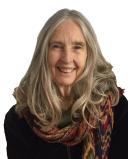
A paradox lies at the heart of human development: In the winter of life we become more freely, audaciously, and powerfully ourselves (authenticity) and at the same time, we grow less concerned with ourselves (self-transcending generosity). A feeling of kinship with other human beings and with all of life often intensifies with age, and the sense of being a separate, solitary self is muted by a deepening experience of interconnectedness.

As we come to know ourselves as part of the web of life, self-importance and self-centeredness wane, and a more humble and generous way of being in the world emerges. Our unique, authentic core does not disappear, but we grow more willing to transcend (literally, “to climb over”) our personal concerns for the sake of something greater.
Self-Transcendence in Later Life
The broadening of focus beyond the personal self is a recurring theme in gerontology, human development, psychology, psychiatry, theology, and other fields. One of my favorite descriptions of this trend comes from Richard Rohr’s Falling Upward. “In the second half of life, it is good just to be part of the general dance. We do not have to stand out, make defining moves, or be better than anyone else on the dance floor. Life is more participatory than assertive, and there is no need for strong or further self-definition.”
Carl Jung was the first in Western psychology to recognize that in midlife we begin to outgrow our ego-based identity and are pulled toward a broader and deeper sense of self that is uniquely individual but also collective. More recently, the Swedish sociologist Lars Tornstam has observed the waning of self-centeredness in later life and the evolution of a broader, more “cosmic” view of the world. Many of Tornstam’s older subjects describe an increased feeling of affinity with other people (including those in past and future generations) and a growing sense of communion with the mystery of life-and-death. Sensing our place in something greater than ourselves, says Tornstam, draws us forward and outward, into a more altruistic relationship with the world.
The 250 Japanese older adults who offered to take the place of young people assigned to clean up nuclear waste after the 2011 earthquake are a powerful example of self-transcending generosity. A desire to give back often intensifies with age and communities around the world are enriched by the large numbers of elder volunteers who collect and distribute food to the hungry, tutor children, offer professional or management assistance to non-profits, serve as foster grandparents, raise funds for disaster relief, and otherwise contribute their life experience, skills, and love to the greater human family.

The Spirituality and Science of Self-Transcendence
The endless, intertwining thread that runs through all of life is reflected in ancient art, and recalling our place in a bigger, more inclusive self is a perennial theme that runs through the world’s religions and spiritual traditions. The process is referred to by many names (ego transcendence, self-forgetting, cosmic consciousness, spiritual awakening, samadhi (union), and the realization of the higher self), but the theme is similar: originally and essentially, we are interconnected in the unending circle of life. For a time, we forget our true identity and unity, and the purpose of life is to wake up and remember who we really are - and to live accordingly.
In recent years, scientists in many fields have begun confirming the oneness of life that spiritual masters have taught for millennia. For example, neuroscientists have discovered that when one person witnesses another’s experience, certain “mirror cells” in the same area of the brain are activated in both participant and observer. Dr. Vittorio Gallese points out, “This neural mechanism is involuntary and automatic . . . It seems we’re wired to see other people as similar to us, rather than different.” In other words, we are neurologically designed to recognize and respond to one another as kin.
Physicists, too, have confirmed that we live in an essentially interdependent universe. Experiments have revealed that even when particles are separated by vast distances, what happens to one particle has a demonstrable effect on the other. And Albert Einstein’s observations convinced him that the fundamental truth of existence is relatedness, not separation: “A human being is a part of the whole, called by us ‘Universe,’ a part limited in time and space. He experiences himself, his thoughts, and feelings as something separated from the rest—a kind of optical delusion of his consciousness.”
The shift from a personality-centered identity to a more inclusive one is a developmental inclination in the winter of life, yet such a fundamental change rarely occurs quickly or smoothly. It challenges the claims of the ego or “little self” and pulls us beyond familiar ways of seeing and being. In addition, this interconnected and interdependent view appears to run counter to much of what twenty-first-century American culture holds dear: independence, self-determination, and individual accomplishment. Yet autonomy and interdependence are not really opposites. We are both individuals and part of something larger, and our unique life experience and authentic gifts are what we have to share with the world.
As Bishop Desmond Tutu points out, “We think of ourselves far too frequently as just individuals, separated from one another, whereas you are connected and what you do affects the whole world.” Age is an ally in reminding us that we are each a unique and beautiful singer in the great chorus of Life.



